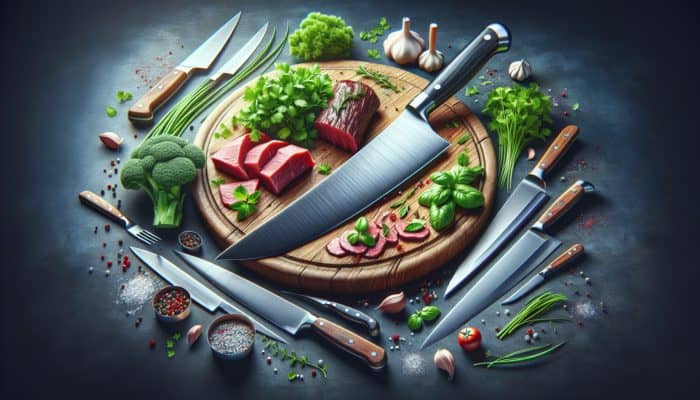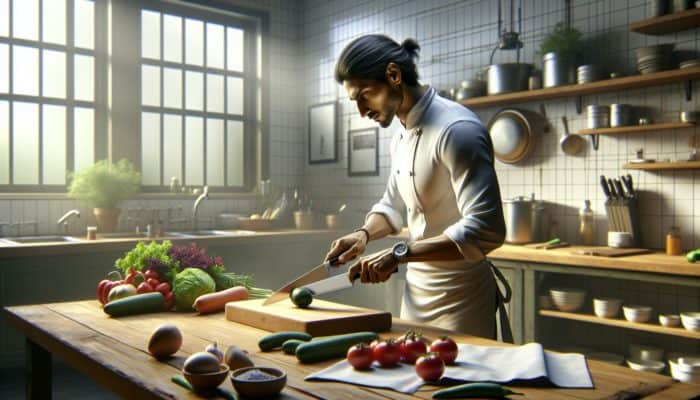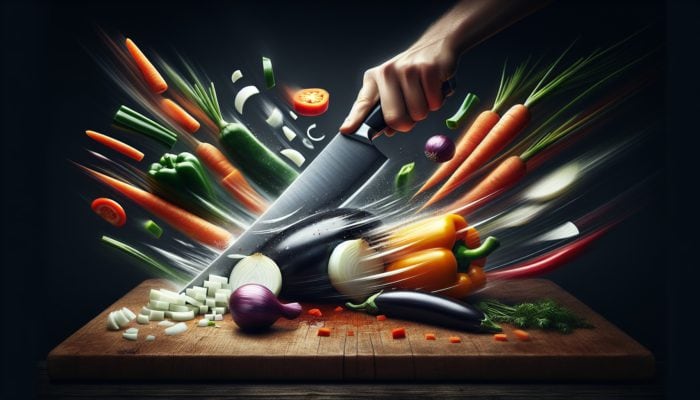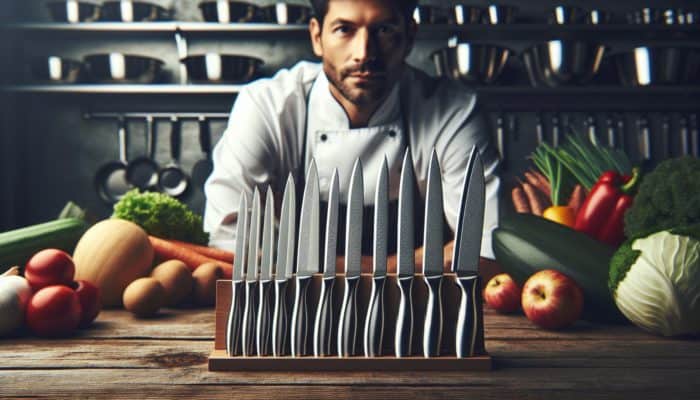Expert Guide to Selecting the Perfect Knife for Your Culinary Needs
Exploring the Diverse Types of Kitchen Knives

How to Sharpen Your Chopping Skills: Selecting the ideal knife is crucial for mastering the art of chopping in the kitchen. The variety of kitchen knives available can significantly influence your chopping efficiency and overall cooking experience. The chef's knife, often regarded as the essential tool in any kitchen, features a broad blade designed for a multitude of tasks, including slicing, dicing, and mincing. Its versatility makes it perfect for everything from chopping fresh herbs to tackling larger cuts of meat, ensuring you have the right tool for every culinary challenge.
On the other hand, the paring knife boasts a smaller blade, making it ideal for intricate tasks such as peeling fruits or deveining shrimp. This knife is invaluable for detailed work where precision is paramount. Utility knives, frequently overlooked, serve as an intermediary option between the chef's knife and the paring knife, offering flexibility for various cutting tasks. Selecting the appropriate knife type not only enhances your culinary creations but also improves safety during food preparation. Gaining an understanding of these classifications equips you with the confidence to tackle any ingredient with ease.
Understanding Knife Materials for Optimal Performance
The material of your knife can greatly influence your culinary experience and performance in the kitchen. Stainless steel knives are popular due to their resistance to rust and corrosion, making them ideal for daily cooking tasks. They tend to maintain their sharpness effectively, though periodic honing is necessary. In contrast, carbon steel knives offer superior edge retention and are easier to sharpen, resulting in a razor-sharp edge that many professional chefs prefer. However, they do require diligent maintenance to prevent rust and discolouration.
Ceramic knives are lightweight and immune to rust, yet they are susceptible to chipping and require careful handling. Each material comes with its distinct advantages and drawbacks, and understanding these nuances helps you select the best knife tailored to your cooking style. By choosing the right material, you not only enhance your chopping abilities but also invest in quality tools that can elevate your culinary adventures.
Determining the Ideal Knife Size and Weight for Comfort
The size and weight of a knife are crucial factors that affect both its effectiveness and your comfort while chopping. A knife that feels balanced and comfortable in your hand can significantly differentiate between an efficient chopping task and a laborious one. It’s essential to consider your hand size and the chopping techniques you plan to use. A heavier knife offers more force when cutting through tougher vegetables, such as squash, but may lead to fatigue during prolonged use.
Conversely, a lightweight knife promotes quicker and more agile movements, making it ideal for delicate tasks. Experimenting with various sizes can help you find the perfect fit, ultimately enhancing your grip and control. Selecting the right knife size that suits your chopping style paves the way for mastery over your blade and enhances your overall cooking efficiency.
Mastering Proper Knife Handling for Safety and Precision

Essential Grip Techniques for Enhanced Control
Mastering grip techniques is essential for developing effective chopping skills. The pinch grip is a technique that provides greater control and stability, particularly beneficial for intricate cuts. To achieve this grip, hold the blade with your thumb and index finger, and wrap your remaining fingers around the handle. This method not only enhances precision but also helps alleviate hand fatigue during extended chopping sessions, allowing you to work with greater comfort.
Alternatively, the handle grip, where your entire hand encloses the handle, offers a comfortable hold for larger chopping tasks. Each grip presents its advantages, and trying both can help you identify which feels more natural for your cooking style. By refining your grip techniques, you enhance your chopping efficiency and reduce the risk of accidents, enabling you to cook with increased confidence and skill.
Optimal Hand Positioning for Safe and Efficient Chopping
Understanding proper hand positioning is vital for safe and effective chopping. Curling your non-dominant hand’s fingers under while holding the ingredient protects your fingertips from the blade. This ‘claw grip’ technique enhances visibility and control, allowing you to chop with greater precision and safety during meal preparation.
Additionally, maintaining a stable cutting board is essential. Ensure your board is secure and does not slide around while in use; this can lead to unfortunate mishaps. Placing a damp cloth beneath the board can provide extra stability. Proper hand positioning not only accelerates your chopping speed but also bolsters safety, allowing you to focus on the joy of cooking rather than worrying about potential injuries.
Fluid Chopping Motion for Efficiency and Blade Longevity

A fluid chopping motion is crucial for maintaining blade sharpness and increasing your cutting speed. Begin with a rhythmic rocking motion, where the tip of the blade remains in contact with the cutting board while the heel of the knife moves up and down. This technique ensures even cuts and prolongs the lifespan of your blade, as excessive force can prematurely dull the edge.
Practising this motion with a variety of ingredients helps build muscle memory, allowing you to chop with increased precision over time. The more you practice, the more efficient and effective your chopping will become. Concentrating on your technique guarantees that each cut is clean and consistent, giving your dishes a polished and professional appearance.
Essential Knife Maintenance for Longevity and Performance
Regular knife maintenance is pivotal in ensuring your culinary tools remain effective and safe to use. Sharpening your knife is crucial for maintaining its cutting edge, while honing realigns the blade's edge to optimise its performance. Investing in a quality whetstone or honing steel is essential for any serious cook seeking to refine their chopping skills in the kitchen.
Establishing a routine to check your knife’s sharpness is essential. A simple test, such as attempting to slice through a piece of paper, can indicate dullness. If you find it challenging to cut through, it’s time to sharpen your knife. By incorporating regular maintenance into your cooking routine, you extend the lifespan of your knives, ensuring they remain a reliable companion throughout your culinary journey.
Advanced Knife Sharpening Techniques for Precision
Mastering the Whetstone for Optimal Blade Sharpness
Sharpening your knives with a whetstone is a traditional technique that delivers exceptional results. To start, ensure your whetstone is appropriate for your knife’s material; most stainless and carbon steel knives respond well to conventional stones. Soaking the whetstone in water for about 10-15 minutes before use creates a slurry that assists in the sharpening process.
Position your knife at a 15-20 degree angle against the stone. Begin at the heel of the blade and draw it across the stone towards you, applying consistent pressure. Repeat this motion several times on each side of the blade. Although this process may seem intimidating at first, with practice, it becomes second nature. Regularly utilising a whetstone not only sharpens your knife but also enhances your overall cutting performance, making it an indispensable skill in your culinary toolkit.
Efficient Honing with Steel for Blade Maintenance
To maintain a knife’s edge between sharpenings, honing with a steel is essential. This technique realigns the microscopic teeth of the blade that become misaligned with use. Begin by holding the honing steel vertically, with the tip resting on a stable surface. Position the knife at a 15-degree angle against the steel and draw the blade downwards in a smooth motion, alternating sides to ensure even honing.
It is crucial to hone your knife regularly—ideally after every few uses—to keep it performing at its peak. This simple practice extends the intervals between sharpenings, ultimately preserving the life of your knife. Incorporating honing into your routine not only enhances your knife's performance but also instils a sense of confidence in your chopping abilities.
Utilising Electric Sharpeners for Convenience
Electric sharpeners provide a convenient option for quickly sharpening knives, particularly for those who may not yet feel comfortable using a whetstone. When using an electric sharpener, ensure you follow the manufacturer’s instructions. Typically, you will need to feed the knife through the designated slots, allowing the machine to perform the sharpening for you.
While electric sharpeners can offer a quick solution, they sometimes remove more material than necessary, which may shorten the lifespan of your blade. Therefore, it’s essential to use them judiciously. Understanding how to integrate electric sharpeners into your knife care routine effectively will help you maintain maximum sharpness while preserving the integrity of your knives.
Essential Chopping Techniques for Culinary Success
Mastering Basic Chopping Techniques for Aspiring Chefs
Mastering the fundamental chopping technique is the cornerstone for any aspiring chef looking to elevate their culinary skills. Begin by positioning your knife correctly, ensuring the blade's edge is sharp and ready for effective use. The motion should be smooth and controlled, originating from the wrist rather than the elbow to maintain precision and reduce effort.
Utilising a cutting board with a non-slip surface can significantly enhance your chopping experience. Ensure the board is clean and dry to prevent slipping. Depending on the ingredient, you might choose to chop using a rocking motion or a straightforward down-and-up movement. Consistency is essential; practice makes perfect, so dedicate time to hone your technique. Mastering basic chopping will lay the foundation for more advanced techniques, allowing your culinary creations to shine truly.
Creating Perfect Julienne and Batonnet Cuts
Learning to create thin strips and sticks not only facilitates cooking but also enhances the presentation of your dishes. The julienne technique involves cutting vegetables into thin matchstick-sized pieces, perfect for use in salads or as garnishes. Begin by cutting the vegetable into manageable sections, then slice each section into thin strips for a uniform appearance.
The batonnet technique takes it a step further, producing thicker strips ideal for stir-frying or sautéing. This technique demands precision, so take your time to ensure uniformity in size. Practising these methods will not only improve your knife skills but also elevate your dishes, giving them a polished and professional look that will impress any diner.
Enhancing Flavours through Mincing and Dicing Techniques
Mincing herbs and dicing vegetables can significantly elevate the flavour profile of your culinary creations. When mincing, employ a sharp knife to finely chop herbs, utilising a rocking motion for optimal results. Fresh herbs, when minced correctly, release their essential oils, intensifying the flavours in your dishes and contributing to a more vibrant culinary experience.
Dicing involves cutting vegetables into uniform cubes, which is crucial for consistency. Begin by slicing the vegetable lengthwise, then cross-cut to achieve your desired cube size. Ensuring uniformity in size not only enhances the cooking process but also improves the texture and taste of your dish. Mastering these essential techniques enables the creation of visually appealing and flavour-packed dishes that can impress anyone at the dining table.
Prioritising Safety and Knife Maintenance in the Kitchen
Essential Knife Safety Tips to Prevent Kitchen Injuries
Implementing essential safety practices while chopping is crucial for preventing kitchen accidents. Always utilise a cutting board specifically designed for knife work, as this provides a stable and safe surface for your chopping tasks. Ensure your knife is sharp; dull blades require more force, which can lead to slips and injuries.
Moreover, maintaining an organised workspace is vital. Remove unnecessary objects from your cutting area, and always remain aware of your surroundings while chopping. If you need to reach for an ingredient, stop chopping first to avoid accidents. A clean and focused kitchen environment is crucial for maintaining safety while refining your chopping techniques.
Proper Cleaning and Storage Techniques for Knife Longevity
Correct cleaning and storage methods significantly impact the longevity and overall performance of your knife. After each use, clean your knives promptly with warm, soapy water, and avoid placing them in the dishwasher, as this can damage the blade and reduce its effectiveness. Ensure your knife is thoroughly dried to prevent rusting, especially with carbon steel knives.
For storage, consider using a magnetic strip or a knife block to protect the blades and maintain their sharpness. Avoid tossing knives into a drawer where they can dull or become damaged. Thoughtful storage practices extend the life of your knives, ensuring they remain reliable tools in your culinary arsenal and ready for your next cooking adventure.
Implementing Regular Maintenance for Optimal Knife Performance
Routine checks and maintenance tasks are vital for keeping your knives in top condition. Regularly inspect your knives for nicks or damage, and address any issues promptly to prevent further complications. Learning to recognise when your knife needs sharpening or honing is an integral part of effective knife maintenance.
Investing time in maintaining your knives ensures they remain effective, reliable tools for any culinary challenge. By embracing these practices, you not only improve your skills but also cultivate a deeper appreciation for the tools that elevate your cooking experience, enabling you to create exceptional dishes with ease.
Strategies for Improving Chopping Speed and Efficiency
Incorporating Practice Drills for Enhanced Speed and Accuracy
To increase your chopping speed and accuracy, integrating effective practice drills into your routine is essential. Dedicate specific time to practice various techniques, such as julienne or dicing, using a timer to track your progress. Begin slowly, focusing on precision before gradually increasing your speed as you gain confidence in your abilities.
Engaging in these drills regularly helps develop muscle memory, allowing for quicker and more efficient movements while chopping. Consider using ingredients with different textures to challenge your skills and improve adaptability in the kitchen. As you practice, you’ll notice a marked improvement in both your speed and confidence, ultimately enhancing your overall cooking experience and efficiency.
Utilising Muscle Memory for Faster Chopping Techniques
Developing muscle memory is essential for executing fast and efficient chopping movements. The more you repeat specific chopping techniques, the more automatic they become. Begin with slow, deliberate movements, then gradually increase your speed as your confidence grows and your technique improves.
Incorporate variations in ingredients and techniques during your practice sessions to keep things engaging and stimulating. Repetition is key; over time, you’ll find your hands intuitively know the right motions, enhancing both your speed and accuracy. By fostering muscle memory, you set yourself up for success in any culinary endeavour, enabling you to create dishes with ease and finesse.
Effective Time Management for Efficient Meal Preparation
Effectively managing time during meal preparation can significantly boost your chopping speed. Organising your workspace before you start cooking can streamline the process; gather all necessary ingredients and tools so everything is at your fingertips, reducing the time spent searching for items during cooking.
Setting a timer for each stage of preparation can keep you focused and encourage quicker chopping without compromising quality. This practice fosters a more efficient cooking environment, helping you learn to chop more quickly while maintaining precision. Being mindful of your time not only aids in cooking but also enables you to fully enjoy the entire culinary experience, from preparation to presentation.
Enhancing Chopping Precision for Professional Results
Improving Knife Control for Consistent Cuts
Enhancing knife control is essential for achieving precise and consistent cuts in your cooking. Start by practising with a dull knife; this will force you to concentrate on your technique rather than relying on the sharpness of the blade. As you gain confidence, switch to a sharper knife and apply the skills you’ve developed to maintain control and accuracy.
Utilise techniques such as the claw grip to protect your fingers while maintaining control over the knife’s movement. Consistent practice with various ingredients will further enhance your skills, enabling you to handle even the most challenging vegetables with ease. Ultimately, refined knife control yields better results in your culinary creations, enabling you to impress your guests with beautifully crafted dishes.
Setting Up an Efficient Cutting Board for Optimal Performance
Optimising your cutting board setup can greatly improve visibility and control during chopping. Ensure your cutting board is positioned at a comfortable height to reduce strain on your back and arms. A non-slip mat beneath the board can prevent unwanted movement, facilitating safer and more efficient chopping.
Consider the layout of your ingredients, placing them within easy reach to minimise unnecessary movements. A clutter-free workspace not only aids in maintaining focus but also promotes better control over your knife. Taking the time to create an efficient cutting board setup allows you to enhance your chopping precision and enjoy a more productive cooking session, ultimately leading to better culinary results.
Preparing Ingredients for Efficient Chopping
Proper preparation of ingredients is critical for facilitating precise and efficient chopping. Thoroughly wash and dry vegetables to prevent slipping and ensure clean cuts. For ingredients with tough exteriors, such as squashes, start by trimming off the ends to create a stable base for chopping.
Consider pre-cutting larger items into manageable sizes before chopping, as this can expedite the process and improve accuracy. A well-prepared workspace lays the foundation for effective chopping, enabling you to focus on honing your skills while creating beautiful, delicious dishes that showcase your culinary talents.
Adapting Chopping Techniques to Various Ingredients
Chopping Different Vegetables with Tailored Techniques
When it comes to chopping various vegetables, techniques may vary based on their texture and firmness. For softer vegetables, such as tomatoes, opt for a serrated knife to prevent squishing. In contrast, hard vegetables like carrots benefit from a sharp chef's knife for clean, precise cuts.
Understanding the unique properties of each vegetable allows you to apply the most suitable technique, enhancing both flavour and texture in your dishes. Practising with a range of vegetables will not only improve your skills but also foster a greater appreciation for the ingredients you work with, allowing you to create dishes that truly shine.
Handling Meat Safely and Efficiently
Handling meat requires specific techniques to ensure safety and precision during the chopping process. Always use a separate cutting board dedicated to meats to avoid cross-contamination with other ingredients. For tougher cuts, let the knife do the work; employ a sharp knife to glide through without applying excessive force.
Cutting against the grain can improve tenderness, enhancing the overall eating experience of your dishes. Practice makes perfect; improving your skills with meat can elevate your culinary creations, allowing you to impress friends and family with expertly prepared dishes that showcase your talents.
Creative Substitutions for Ingredients in Your Recipes
Finding suitable replacements for unavailable ingredients can be a daunting task, but understanding how to adapt allows you to maintain dish quality while preserving taste. Familiarise yourself with flavour profiles and textures of common ingredients to ensure your substitutions work harmoniously within the recipe.
For instance, if a dish calls for a specific herb or spice that you can’t find, consider using dried alternatives or similar flavours to achieve a comparable taste. Developing a repertoire of substitutions can enhance your cooking confidence, empowering you to tackle any kitchen challenge while refining your chopping skills.
Adjusting Seasonings for Perfectly Balanced Flavours
Adjusting seasonings to complement different ingredients and personal taste preferences is vital for creating memorable dishes. Cultivating a palette for balancing flavours—understanding how salt, acidity, and sweetness interact—can transform a dish from average to extraordinary.
When substituting ingredients, it’s important to recalibrate your seasoning levels accordingly. For example, if replacing a milder vegetable with a more robust option, be prepared to adjust the amount of salt and spices to maintain balance. Mastering the art of seasoning not only elevates your dishes but also enhances your overall cooking skills, enabling you to create culinary masterpieces.
Your Frequently Asked Questions Answered
What is the best type of knife for a beginner chef?
A chef's knife is often recommended for beginner chefs due to its versatility and ability to perform a wide range of culinary tasks effectively.
How often should I sharpen my kitchen knives?
It’s advisable to sharpen your knives every few months, depending on your usage frequency. Regular honing can extend the time between necessary sharpenings.
Can I use a whetstone for ceramic knives?
No, ceramic knives require specific diamond sharpeners, as they are too hard for traditional whetstones to sharpen effectively.
What is the difference between honing and sharpening a knife?
Honing realigns the blade's edge, while sharpening removes material to create a new edge. Both processes are crucial for maintaining a knife properly.
How should I clean my knives after use?
Clean your knives with warm, soapy water immediately after use. Avoid placing them in the dishwasher, as this can damage the blades over time.
What is the best way to store my kitchen knives?
Store knives in a magnetic strip or a knife block to protect the blades and keep them sharp for longer periods.
How can I improve my chopping speed?
Regular practice, establishing a dedicated routine, and utilising cutting drills can significantly enhance your chopping speed and overall efficiency in the kitchen.
Are electric sharpeners suitable for all types of knives?
Electric sharpeners work well for many knives but can sometimes remove more material than necessary; therefore, it’s essential to use them judiciously and infrequently.
What is the claw grip technique in knife handling?
The claw grip is a hand positioning technique wherein your non-dominant hand holds the food with fingers curled under, keeping them safe from the knife blade during chopping.
How do I know when my knife needs sharpening?
If your knife struggles to cut through paper or requires excessive force to slice through ingredients, it's indicative that it’s time to sharpen your knife.



Your exploration of the different types of kitchen knives really highlights the importance of selecting the right tools for specific culinary tasks, which is something that often gets overlooked by novice cooks. I have found that investing in a good chef’s knife was a game-changer for me in the kitchen. Initially, I was intimidated by the array of options available, but once I made a decision based on the criteria you laid out—like blade shape and versatility—I noticed a significant improvement in my chopping skills and overall efficiency.
Your exploration of kitchen knives highlights the profound impact these tools have on both efficiency and enjoyment in cooking. As someone who has dabbled in various culinary styles, I’ve found that investing in a quality chef’s knife truly transforms the experience, making prep work feel less like a chore and more like an art form.